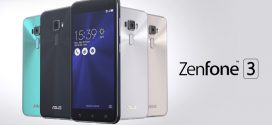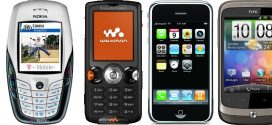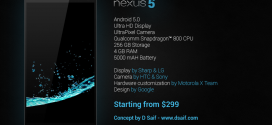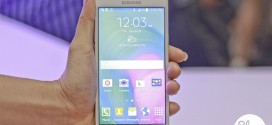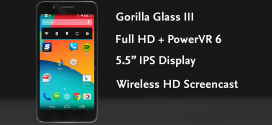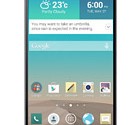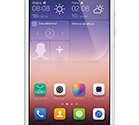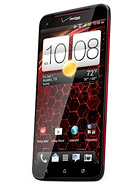 Today we’ll be taking a look at the HTC Droid DNA. This is a pretty exquisite phone, andits design is absolutely brilliant. By looking at it, you’d think it was extracted from one of those futuristic sci-fi movies. It’s extremely thin, or so its design gives the impression. Not only that, but it’s also extremely beautiful and has a whole lot of features. Some may think it a bit large ( it’s definitely larger than the Galaxy S3, but not bigger than a Galaxy Note ), but I personally enjoy a larger phone, as I have relatively large hands and find it more practical to have a 5.0 or a 5.5 inch screen.
Today we’ll be taking a look at the HTC Droid DNA. This is a pretty exquisite phone, andits design is absolutely brilliant. By looking at it, you’d think it was extracted from one of those futuristic sci-fi movies. It’s extremely thin, or so its design gives the impression. Not only that, but it’s also extremely beautiful and has a whole lot of features. Some may think it a bit large ( it’s definitely larger than the Galaxy S3, but not bigger than a Galaxy Note ), but I personally enjoy a larger phone, as I have relatively large hands and find it more practical to have a 5.0 or a 5.5 inch screen.
The screen size is not the only interesting thing about this device, but you will come to know about them in just a few short minutes. One thing I have to point out: this phone will be limited to a few select areas, as it is only available for Verizon. That is disappointing to see, but if you truly want it you can easily get your hands on one, break its network encoding and make it run on all networks. Sure, it may take a bit of time and coin to achieve, but in the end this phone is pretty much worth it.
While the profits of HTC didn’t turn out so well these past few months, one would be a fool not to think they would drastically increase with the release of this phone. The HTC Droid DNA, the newest flagship of HTC, will most surely tilt the tide in their favor. This is a device that has some of the more powerful pieces of technology of our day, and even a few revolutionary pieces that are hard to find due to the fact that they are so new. You will see what I mean when you reach them.
SUMMARY
As I promised I’d do such a very long time ago, I’d start my reviews off with a brief summary of the good features and the less-than-ideal ones. This summary is more intended for those who do not want to sit and read through the full review. If you want to know the specific details about this phone, feel free to skip through this particular part, as it will offer you no useful details about it.
One of the best things about this device is its screen. The screen is one of the most exquisite ones as of yet. It hasn’t really been implemented so well into a whole lot of devices. Therefore, I can honestly say that I am eagerly awaiting its release to see how well it functions. Though in theory I know it will be one of the finest ones yet and it can handle a whole lot, I long to hold it and experience it myself first-hand.
Next to the fine display of this device is the design, being so beautiful that one can easily mistake it for some prototype that is mostly built in PhotoShop and likely to never actually hit any shop or see the light of day as a practical phone. The fact that this phone is actually something REAL and we know it will come out and exactly WHEN it will come out, makes it almost like a dream come true.
Now normally in these little summaries I try to talk about the bad things of the device as well. The fact that this phone has no bad points makes me not be able to talk a whole lot about it. Perhaps the only true disadvantages are the ones that it has a limited area in which it will come out and the fact that it has no Card slot. Therefore, you’ll have to settle for the storage space this phone offers, which in my opinion is still more than I would ever require. But then again, if you try to add some really graphics demanding games that occupy 1 or 2 GB each, that storage space will become invaluable.
GENERAL
This is a device which offers you the possibility of choice. You can choose to either get the CDMA one or the regular GSM one. Also, both of them are 4G phones. The networking supported by the HTC Droid DNA is as following: 2G ( which is either CDMA 800 and CDMA 1900 or GSM 850, GSM 900, GSM 1800 and GSM 1900 ), 3G ( which is CDMA 2000 1xEV-DO or HSDPA 850, HSDPA 900, HSDPA 1900 and HSDPA 2100 ), and also 4G ( which is only LTE ). The HTC Droid DNA has a Micro-SIM card on it. I guess this seems to be the trend nowadays, but I personally use phones that have Mini-SIM, and would be somewhat of an inconvenience to change them. This device was announced in November 2012 and it is set to come out somewhere around November 21st 2012.
BODY
The body of this device is a real piece of work, I’ll tell you that. It is sleek, think, smooth and elegant. This device is around 141 x 70.5 x 9.7 mm big, or if you prefer it this way, 5.55 x 2.78 x 0.38 in. The weight of this phone is around 138 g, or if you prefer it like this, 4.87 oz. This phone also has Touch-Sensitive Controls instead of buttons or that bar that holds the buttons and occupies a small part of the screen.
DISPLAY
The display of this device is some sort of revolutionary technology that can easily be classified as the smoothest available at the current time. The display of this screen is a Super LCD3 capacitive touchscreen of 16 million colors. This screen is perhaps the only one capable of putting 1080p resolutions in 5.0 inches screens.
The resolution of this screen is 1080 x 1920 pixels. That’s pretty darn impressive as the screen is only 5.0 inches big. Heck, that resolution is impressive even on 15.6 inch screen laptops, so you know how good it is for a 5.0 inch phone to have one. The pixel density of this device is astonishing. One cannot help but wonder what unholy magic was used to create such a fine display. Remember how most experts claimed that 300 is the maximum amount of ppi that the human eye can perceive, thus being the finest around. Well, the pixel per inch density of this device is so much more than that – 441 ppi to be more exact. Try as you will, but you won’t find something better than that.
This device also has Multitouch on it, however, it isn’t the advanced sorts that Sony is using on most of their Xperia phones, the kind that can support more than 2 simultaneous fingers. The screen protection method of this device is one of the finest available. The screen protection of this device is Gorilla Glass 2. This device also has the HTC Sense UI 4+ on it. In case you don’t like it, I suppose certain UIs can be deactivated, but others harder to turn off.
SOUND
The phone doesn’t necessarily have any sound enhancements. Well, they aren’t really notable, but the device still sounds really good. If you look at it, it has its back engraved with Beats Audio, therefore I’d think that it should sound pretty well. Now many people claim that this Beats by Dre or whatever they’re called are the best. I’ve had a chance to test them, and I can’t say they’re too great. I’ve used much better headphones at a much smaller price. Well, back to the matter at hand. This device is pretty much standard issue as far as the rest of the things are concerned. The sound jack, alert types and the rest are all default, as all devices have.
MEMORY
The internal storage space of this device, as I’m sure I’ve already mentioned, is extremely large. The HTC Droid DNA has an internal storage space of 16 GB, however, out of that space only 11 GB are user-available. The rest of the storage space is dedicated towards the use of the system. As I already said, its only true disadvantage is that it is lacking a card slot. Therefore, you will have to limit yourself wisely with space consumption for apps. The RAM of the HTC Droid DNA is one of the best availble – 2 GB, to be more exact. This is the current maximum amount of RAM supported by mobile devices.
DATA CONNECTION
First of all, this device is an NFC equipped phone. In case you’re wondering, the NFC stands for Near Field Communication and it is sort of like a very fast infrared connection. Except, the distance needs to be less than 5 cm between the two devices. Be that as it may, it only represents a small disadvantage, considering the files are shared almost instantly.
The HTC Droid DNA is equipped with both GPRS and EDGE. While I am unaware of what Class they each are, or what speed they can both reach, I am confident that they can each reach astonishing speeds. The Speed per say of this device is as following: HSPA, Rev A of up to 3.1 MB/s, LTE, Cat 3 of 50 MB/s Upload and 100 MB/s Download. The WLAN of this device is Wi-Fi 802.11 a/b/g/n with Wi-Fi Direct, DLNA and Wi-Fi Hotspot. This phone also has Bluetooth v4.0 with A2DP on it. Also, the USB port of this device is a Micro-USB v2.0 ( MHL ) one. Being an MHL port, that means that it does not require any HDMI cable as all can be done via its MHL A/V link cable.
CAMERA
The primary camera of this device is an 8 MP one that can photograph at resolutions of around 3264 x 2448 pixels and record video in 1080p full HD at around 30 frames per second. The features of this camera include: autofocus, LED flash, simultaneous HD video and image recording, geo-tagging and face and smile detection. Also, the HTC Droid DNA has a few features of the video recorder as well: stereo sound recording and even video stabilization. This phone also has a secondary 2.1 MP frontal camera. This is a pretty interesting thing, as most secondary camers are limited to up to 2 MP. This camera can record in 1080p full HD as well, at around 30 frames per second.
BATTERY LIFE
The only known thing about this battery is its voltage. The rest, I am sorry to say that I do not know how long this battery can keep the device alive. The battery is a Standard Li-Ion 2020 mAh battery.
HARDWARE
The hardware of this device is a very powerful one. The hardware configuration is comprised of: Qualcomm MDM615m or APQ8064 chipset, a Quad-Core 1.5 GHz Krain processor and an Adreno 320 GPU. In conclusion, this hardware is strong enough as to run any app and just about any game for months to come ( which in terms of Android and mobile devices, is a very long time ).
SOFTWARE
The Android OS on this device is Android OS v4.1 Jelly Bean. Also, this device can be upgraded as far as the OS is concerned. It can handle to upgrade to Android OS v4.2 Jelly Bean ( I never really understood why they chose to use the exact name for both of them ).
FEATURES
The HTC Droid DNA is packed with all sorts of features. The sensors of this device include: Accelerometer, Gyroscope, Proximity sensor and Compass. The messaging on this phone is done via: SMS ( with Threaded View ), MMS, E-Mail and Push E-Mail. The browser of this phone uses HTML5 and has no apparent support for Adobe Flash. However, considering Android 4.x comes with Adobe Flash already on it, I don’t think that’s an actual problem. Also, it has yet to be decided whether or not this device will have a radio. The GPS of this phone has A-GPS support and it also has GLONASS. This device also has Java through a Java MIDP emulator. The only available color for this phone is Black, however, it looks positively gorgeous in that color.
Here is a brief list of what the HTC Droid DNA can do:
- SNS integration
- Active noise cancellation with dedicated mic
- TV-out (via MHL A/V link)
- DivX/XviD/MP4/H.263/H.264/WMV player
- MP3/eAAC+/WMA/WAV player
- Google Search, Maps, Gmail, YouTube, Calendar, Google Talk
- Organizer
- Document viewer/editor
- Photo viewer/editor
- Voice memo/dial/commands
- Predictive text input
This concludes our little review of the HTC Droid DNA. Thank you for reading this review. I hope it has been as helpful as possible. If you feel that anything is lacking from this review feel free to leave your suggestions in the comment section below for things which should be added and I will be sure to take them into consideration when writing my future projects. In the meantime, I sincerely hope you had as much fun reading my little review as I had writing it.


